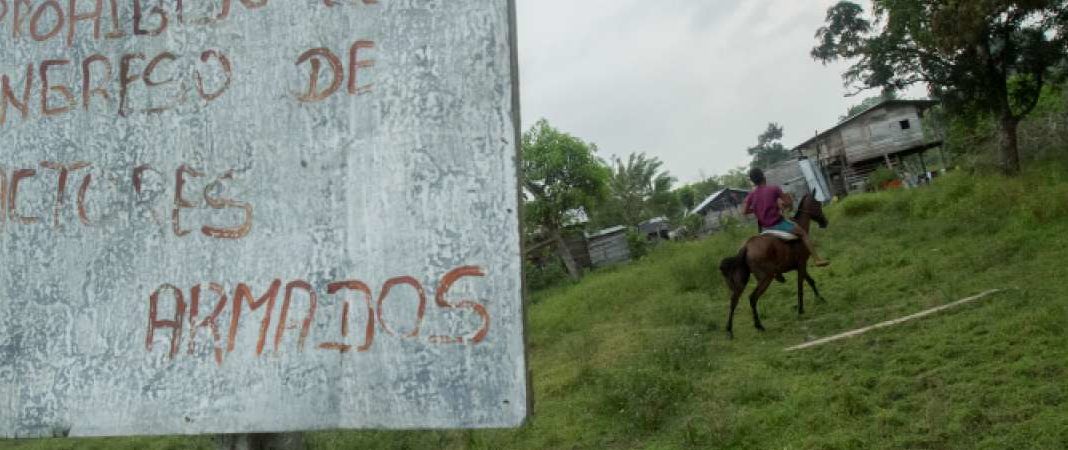Colombia is once again at the of international news stories, with the announcement of a return to arms by some former leaders of the main guerrilla group, the Fuerzas Armadas Revolucionarias de Colombia (FARC). The peace agreement, signed in 2016, is at risk. Why has this happened? Here, we share the views and experiences of AfroColombian and Indigenous communities in Valle del Cauca, an area profoundly affected by the conflict.
This blog draws on Ten Years, a study by Christian Aid that is exploring changes in the lives of people in poor and marginalised communities in Colombia and Kenya, alongside changes in their national contexts. In the Valle del Cauca, the study is being carried out by human rights organisation the Inter-Church Commission for Justice and Peace (CIJP), which is building on its existing relationships with Afro-Colombian and indigenous Wounaan communities to capture learning about how they are experiencing the local changes brought by the national peace agreement.
Members of these communities note the ongoing presence of both new and familiar armed actors in their territories; and they point the government’s own lack of observance of the peace agreement. These views help understand why the agreement is now weak and exposed, leading to retrograde steps like the FARC return to arms.
Ongoing presence of familiar and new armed actors
Since the signature of the peace agreement, which saw the FARC lay down arms, other armed actors have rearranged themselves to step in the space left by FARC. Indigenous governors from Bajo Calima and Bajo San Juan noted that the guerrilla group Ejército de Liberación Nacional (ELN), the Clan del Golfo (one of Colombia’s most powerful paramilitary groups involved in the drugs trade) and government forces are in dispute on their territory. This dispute, focused on the control of illicit drug trafficking, has restricted the mobility of communities.
The situation worsened a year ago, in November 2018, when rapid boats with uniformed people carrying long-range weapons were seen and heard moving along the river. Some armed actors – reported to be FARC dissidents – entered and stayed in Community Humanitarian Reserves (established as safe community spaces) for some hours. When community members complained about these violations, their leaders were threatened by guerrilla and paramilitaries. While government forces are present in the area, communities remain fearful of threats and the recruitment of their children as soldiers. Unable to access and make a living from the land and rivers closest to their communities, they are often forced to displacement.
In the Naya river basin, the ELN, FARC dissidents and a paramilitary-oriented structure Fuerzas Unidas del Pacífico, founded in 2018 to fight for control of the territory, are all currently active. Despite the presence of government forces in the area, four members of the Community Council disappeared in 2018 and several families have been displaced.
Overall, community members in both the San Juan and Naya areas say that risk levels have increased in 2019, with more armed actors present.
Breach of the peace agreement by the government
Since the peace agreement, the government has not been able to secure peace in these territories. Armed incursions are made into humanitarian reserves. Communities, such as the Pichimá Quebrada in San Juan, have to either be displaced, or be confined. Leaders continue to be intimidated, kidnapped and killed.
On 24 May 2019, the young Naya leader Nidíria Ruiz Medina received a death threat – ‘a bullet for Nidíria Ruiz’ under the door of the house of a family member in Puerto Merizalde, Buenaventura. Nidíria Ruiz is a leader of AINI, a women’s organisation in the Naya river basin. She coordinates work on memory, peace and the environment.
On top of the continued tensions in these territories, the government has failed to change many of its old practices. While attempts to compensate farmers for alternatives to illicit drug crops have been made, President Duque also said that glyphosate fumigations would continue. For communities, this old practice means a fumigation of all their livelihoods, because the pesticide kills food crops alongside illicit drug crops. “For us,” a leader from a Biodiversity Reserve in San Juan noted, “it means that there is no agreement.”
The government has also failed to fulfil the actions agreed in Point 4 of the peace agreement, which include no stigmatisation of farmers as drug traffickers, ensuring road infrastructure, a guarantee of commercialisation of products, and allowing farmers to voluntarily decide on alternatives to illicit drug crops such as coca.
Additionally, community leaders argue that the Colombian government is seeking to eliminate the administrative autonomy legally conferred on AfroColombian and Indigenous communities. For instance, the government wants to modify Law 70 on the protection of Afro-descendant communities, and the Law 21 on indigenous reserves in the national development plan. With these modifications, the territories would be open to transnational mining industries focused on large-scale gold extraction. In the past, such large-scale projects have often been socially and environmentally unsustainable.
Civil response to the situation
The ongoing presence of familiar and new armed actors, as well as the breaches of the peace agreement by the government, have put progress towards peace at risk and may have affected FARC’s decision to return to arms.
CIJP are working to respond to this situation. To guard against armed actors, they are innovatively geo-referencing the areas declared safe spaces together with communities, sending the data to the Inter-American Commission on Human Rights so that they can better protect the demarcated territories.
They are also aiming to ensure that the government guarantees a safe return to communities, as with the pending case of displaced Wounaan indigenous groups from the Pichimá Quebrada area. Work is also being done to prevent the forced recruitment of children. Such civil responses all have the aim of bringing lasting peace to Colombia.
This blog is based on research carried out by Santiago Mera of CIJP, with the support of Pedro Lazaro at Christian Aid Colombia. Kas Sempere works in Christian Aid’s Research, Evidence and Learning team in London.


